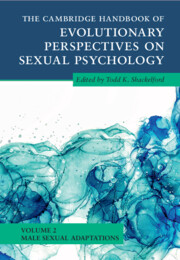Book contents
- The Cambridge Handbook of Evolutionary Perspectives on Sexual Psychology
- The Cambridge Handbook of Evolutionary Perspectives on Sexual Psychology
- Copyright page
- Contents
- Contributors
- Preface
- Part I Precopulatory Adaptations
- Part II Copulatory Adaptations
- Part III Postcopulatory Adaptations
- 14 Postejaculatory Adaptations to Self-Semen Displacement
- 15 Male Mate Retention
- 16 Shifts in Partner Attractiveness
- 17 Emotional Commitment in Men
- 18 Sexual Jealousy in Males
- 19 Men’s Attachment-Related Needs in the Sexual Arena
- 20 Paternal Care
- 21 Paternal Filicide
- Index
- References
20 - Paternal Care
from Part III - Postcopulatory Adaptations
Published online by Cambridge University Press: 30 June 2022
- The Cambridge Handbook of Evolutionary Perspectives on Sexual Psychology
- The Cambridge Handbook of Evolutionary Perspectives on Sexual Psychology
- Copyright page
- Contents
- Contributors
- Preface
- Part I Precopulatory Adaptations
- Part II Copulatory Adaptations
- Part III Postcopulatory Adaptations
- 14 Postejaculatory Adaptations to Self-Semen Displacement
- 15 Male Mate Retention
- 16 Shifts in Partner Attractiveness
- 17 Emotional Commitment in Men
- 18 Sexual Jealousy in Males
- 19 Men’s Attachment-Related Needs in the Sexual Arena
- 20 Paternal Care
- 21 Paternal Filicide
- Index
- References
Summary
Human offspring require intensive and extended parental care. While the needs of offspring have been argued to drive paternal investment, the evolution of male care and its patterning across cultures defy any simple story. Because human paternal investment, while often substantial in relation to other animals, is facultative rather than obligatory, there is considerable cross-cultural variability in how and how much fathers invest in their children. While cooperative and flexible parenting strategies are present across human societies, male investment is heavily influenced by life history tradeoffs. Specifically, when fitness payoffs towards time and energy allocated to mating effort outweigh parenting effort, men often invest less in their children. Moreover, although men appear to be physiological responsive to childcare responsibilities (through testosterone adjustments), paternal loss often has little effect on child survival. Rather than signifying the unimportance of fathers, it highlights the remarkable flexibility in the human family in terms of how mothers are assisted in raising multiple dependent offspring at the same time. Although some form of pair-bonding is observed cross-culturally, with mothers as the primary infant caregiver, extended kin and alloparental support are also important for offspring success. I review paternal investment from across the animal kingdom, discuss the evolution of paternal care in humans, and describe variability across individuals and groups in the ways and amounts men invest.
Keywords
- Type
- Chapter
- Information
- Publisher: Cambridge University PressPrint publication year: 2022



